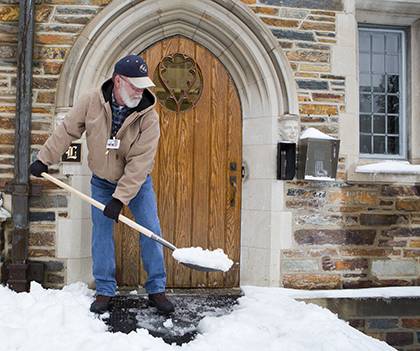Duke Outlines Plan for Severe Winter Weather
Faculty, staff encouraged to avoid campus shortcuts during winter storms

When Valorie Little arrived for work at Duke’s Carolina Family Practice office in Cary last Jan. 30, a touch of snow and thin layer of ice still coated the ground.
She parked, got out of her car and decided to take a short cut of about five steps down a gentle, grass-covered slope.
Read More“I immediately thought, ‘I better not slip,’ and as soon as that happened I lost my footing and went right down,” said Little, a patient service associate who had hip replacement surgery three months prior. “I had snow down my pants, up my shirt, and my lunch bag went flying. A coworker nearby grabbed my orange as it rolled away.”
Luckily, Little wasn’t hurt beyond a few aches the next day, but the impact of the event stayed with her longer.
“God forbid I had done something to my hip,” she said. “It’s worth taking an extra minute or two to use a walkway. There’s no need to rush like that.”
Little’s experience was not unique last winter – between December 2013 and March 2014, employees submitted 65 workplace injury reports related to severe weather. The incidents ranged from bruises and scrapes to broken bones.
Chip Kyles, director of Workers’ Compensation, said that most incidents happened because faculty or staff used uncleared paths that are typically safe during warm months.
To stay safest during severe weather, Duke community members are reminded to follow the campus snow and ice removal plan, which clears priority sidewalks and building entrances. Areas to avoid are sloped surfaces, stairs, ramps and paths not identified as preferred routes, according to the plan.
With the official start of winter on Dec. 21, staff and faculty are encouraged to review Duke’s severe weather policy to prepare for potential ice and snow this season and to ensure roles and responsibilities are understood during severe weather.
This season, the National Weather Service reports the Southeast may see below-average temperatures and above-average precipitation this winter, but a repeat of last year’s extreme cold, snowy conditions is unlikely.
“We’re expecting a weak El Nino to form, which is usually what happens during years that are a little wetter and a little cooler,” said Katie Dedeaux, a forecaster with the Weather Service’s Raleigh office. “That doesn’t necessarily mean snowy or icy conditions, as those are hard to predict in the long term.”
January and February are historically the busiest months for snowfall in North Carolina, with two-to-three inches coming in each of those months.
Small adjustments have been made to Duke's snow and ice plan that reflect ongoing construction and renovations across campus. Ongoing work may create some inconveniences as Facilities Management staff focus on primary walkways and roads, and pedestrians and motorists should use care on and around campus at all times.
“It’s important for Duke faculty and staff to be familiar with Duke’s severe weather policy and think in advance about what they’d do in a weather emergency,” said Kyle Cavanaugh, Duke’s vice president for administration. “It’s never too early to prepare for potentially severe winter storms.”
In the snow and ice removal plan, areas across Duke are sectioned into precincts with parking lots, sidewalks and building entrances cleared according to priority. Priority generally starts with Duke-owned roads, followed by some parking lots and garages, bus stops, pedestrian pathways and building entrances. Depending on the severity of a winter storm and scheduled events on campus, priorities are subject to change.
During a winter weather event, the University and Health System share responsibilities in providing removal by clearing priority areas first but not all areas can be cleared at once. With 48 miles of sidewalks at Duke, crews focus on main campus (West, Central and East) and Duke-owned off campus properties. A map of priority areas to be cleared is available at online.
For a moveable snowfall of about three inches, it will take crews four to six hours after precipitation ends to clear priority sidewalks and roadways. For bigger storms, clearing priority areas could take eight or more hours.
Facilities Management administrators said no storms are alike, so it's impossible to have a uniform amount of time to clear all priority areas of campus.
More information about Duke’s severe weather policy, including a snow/ice priority-clearing map, is at emergency.duke.edu. In the event of severe weather, employees should monitor the website or call (919) 684-INFO for updates.